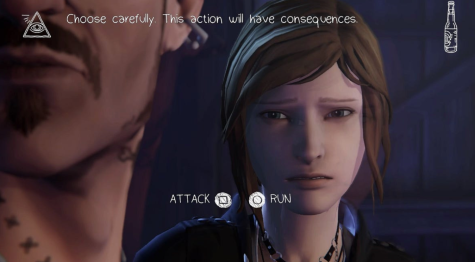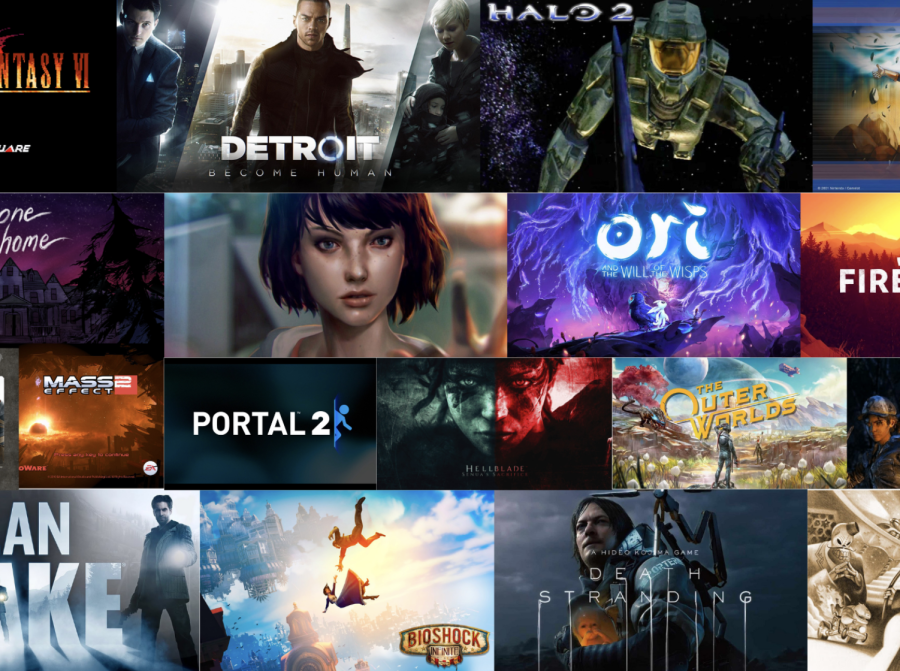Video Games: A New Medium for Storytelling
Just a few weeks ago, The Super Mario Bros. Movie released and became a hit instantaneously. The movie is based on Nintendo’s Super Mario, one of the most iconic video game series in history. In recent years, there has been a notable increase in the number of movies being adapted from popular video games, signaling a growing interest in the crossover between the gaming and film industries.
Earlier this year, The Last of Us, a TV show based on a video game of the same name, came out and was met with widespread acclaim. In past years, releases like Uncharted, a movie starring Tom Holland, and Arcane, a TV show based on the video game League of Legends, have proven to be increasingly popular. Video game to movie adaptations haven’t done well in the past, but it seems like Hollywood is on a good streak, with the most recent examples being average at worst and jaw-droppingly stunning at best.
When The Last of Us TV show started airing, people began comparing its details to the video game online. Most people thought it was an incredible TV show, but it didn’t capture the experience of the video game. Nowadays, stories in video games capture the audience in a completely different way than stories told in other mediums, like books or movies. Game designers are working to tell new stories in creative ways using the unique video game format.
It started in 1981, when Nintendo released Donkey Kong, which is considered the first video game with a storyline. The opening cutscene depicts a big monkey kidnapping Princess Peach and climbing a couple of layers of girders. The main character Mario’s movements are then turned over to the player, who is left to navigate each level of the game in order to save the princess. Since those early days, video games have evolved significantly. Nowadays, games can include hours of cutscenes that, when compiled into one, rival the length of two movies put together.
To set the stage, let’s look at just how significant the video game industry has become. In 2021, the global game market had $180 billion in revenue, which was bigger than the film and music industries put together. Big video game releases consistently financially outperformed top selling movies from the same year, except for the very biggest blockbusters like Avengers: Endgame.
 Let’s use The Last of Us as an example. This game was touted as revolutionary when it first came out. It was all the buzz in video game circles and has won many awards in almost every category (Best Voice Actor, Best Soundtrack, etc). Most of all, it gained recognition for its storyline. In December 2022, Naughty Dog, the developer of The Last of Us, revealed that the franchise (two games and one remake) had sold more than 37 million copies since the first game came out in 2013, with each copy being sold for around $49.99. In its first week alone, The Last of Us (2013) raked in more than 1 billion dollars. Comparatively, Avengers: Endgame made around 650 million dollars in the first week (although now it’s said to have made 2.798 billion dollars altogether).
Let’s use The Last of Us as an example. This game was touted as revolutionary when it first came out. It was all the buzz in video game circles and has won many awards in almost every category (Best Voice Actor, Best Soundtrack, etc). Most of all, it gained recognition for its storyline. In December 2022, Naughty Dog, the developer of The Last of Us, revealed that the franchise (two games and one remake) had sold more than 37 million copies since the first game came out in 2013, with each copy being sold for around $49.99. In its first week alone, The Last of Us (2013) raked in more than 1 billion dollars. Comparatively, Avengers: Endgame made around 650 million dollars in the first week (although now it’s said to have made 2.798 billion dollars altogether).
Comparing the video game industry to the book industry now, it looks like video games have also outdone books. The Last of Us Part I—a remaster of the first game—came out in 2022. One of the top-selling books published in 2022 was I’m Glad My Mom Died by Jennette McCurdy. In the first week, I’m Glad My Mom Died sold over 200,000 copies, at around $20 each—much cheaper than the $70 sticker price of the remaster—and clocking in at much lower total sales earnings than The Last of Us.
It’s not an overestimation to say that the video game industry is thriving; and if the latest popular video games are any indication, their stories can greatly contribute to their popularity. So what makes stories told through video games unique? On the surface, they do seem very similar to movies. Cutscenes are usually shot the same way movies are, with a set script and basic scene structure. But looking closely, there are actually quite a lot of differences between video games and previous storytelling mediums.
Firstly, the biggest difference is the level of immersion video games provide. In both books and movies, the story is generally very rigid. There’s usually very little left for the audience to interpret. Video games add a whole new level of permutation, not just at the end, but throughout the game. In some games, players can change the story significantly based on how they play, which means they have control over the story and can connect to the experience easier. A game that utilizes this in interesting ways is called Life is Strange. Max Caulfield, the main character, discovers she has the abilities of foresight and rewinding time. The player accompanies Max along the journey and makes decisions that directly change the story. When the player is faced with one of these choices, a little message will inform the player that their choice will impact the narrative.

There are quite a lot of choices; this website tracks each one and how it impacts the narrative. Another fun mechanism enabled by this mechanism is that, because of Max’s power, the player can choose to rewind time and make a different choice.
Because this game deals with some very serious and difficult choices, the player feels real pressure. For example, the choices the player makes influence whether or not another character, Kate Marsh, dies from suicide. The game makes sure these choices are given time and magnitude, and as a result, the player most definitely feels the weight. This directly ties the player to the characters and the situations they find themselves in.
This is not to say that movies and books can’t make the audience feel very real emotions—it’s extremely emotional if you watch a character make tough decisions and face consequences. It can even be really frustrating if you know the choices they’re making are wrong. But it’s something else to make that choice yourself, in a much more intimate way.
Another difference that comes with video games is the length of the experience and amount of information the player is presented with. Some video games are designed to take the player months to get through. This only works with video games, not movies or books, because the story is mixed in with gameplay. Movies have a cap at about four hours; any longer and it would feel like a lecture. But with video games, most of the time spent in the game is taken up by gameplay, so there are natural breaks from the story. Maybe you watch a five minute cutscene, and then it takes a week to get through a hard level, and then you’re rewarded with another cutscene and maybe a few choices.
Video games also use the environment to present the player with more information than can be shown in a book or movie. This might mean placing a newspaper on the ground or hiding a notebook the player can interact with behind a puzzle. Through these objects, players can learn more about the world inside the video game and the people that inhabit it. This is more subtle storytelling than info-dumping in cutscenes, and it rewards the player for taking the time to analyze their surroundings. Good game designers, by arranging objects or designing levels in a specific way, can pack in so much information about the world and the characters this way—information that would be dull if it was all written out or read aloud.

Lastly, video games have to balance story with gameplay. A video game could have an incredible story, but if the gameplay itself is clunky or boring, chances are the game is going to get dropped. This allows designers to get creative with traditional story structures, as people can generally slog through a bad story for a good game, but won’t tolerate a bad game for a good story.
And good designers will tie the story to the gameplay, so they both enhance each other. An example of this is with a subgenre of adventure video games where the whole premise is the player exploring an abandoned place. I watched a really incredible video called The Power of Abandoned Places that touched on this, which I highly recommend. Video games like Everybody’s Gone to the Rapture, Tacoma, and Gone Home place the player in a space with the only objective being to explore. Through exploring, the player is gradually given more information on where they are and the story behind the people who used to inhabit that space. After taking the time to carefully interact with the physical space, the player is rewarded with pieces of a story that connect into a narrative. The satisfaction of all the hard work paying off, combined with the occasional haunting or emotional story makes these video games a unique experience that I don’t think movies or books can capture in the same way.
The whole industry of video games is expanding, and the way stories are told in video games is changing to provide new experiences to players. Harvard has even started offering a course called “English 189v.g: Video Game Storytelling” that counts for English credit, and it’s been met with lots of excitement and interest. In the future, the level of immersion video games provide could change with the developing technology in VR. I’m excited to see: 1) How storytelling in video games changes and evolves, 2) If and how storytelling in video games changes the way we tell stories in general, and 3) How successful Hollywood will be in adapting video games to the silver screen.
For anyone interested, here are some other resources you can check out:
https://sbanimation.com/the-importance-of-video-game-narrative/
https://www.sundance.org/blogs/program-spotlight/the-art-of-storytelling-in-gaming/
https://scholarcommons.sc.edu/cgi/viewcontent.cgi?article=1165&context=tor
https://www.gamedeveloper.com/design/environmental-storytelling#close-modal
https://www.youtube.com/watch?v=LGyx-G4HPnc

















![Dr. Zanita Kelly, Director of Lower and Middle School, pictured above, and the rest of Westridge Administration were instrumental to providing Westridge faculty and staff the support they needed after the Eaton fire. "[Teachers] are part of the community," said Dr. Kelly. "Just like our families and students."](https://westridgespyglass.org/wp-content/uploads/2025/03/dr.-kellyyy-1-e1748143600809.png)
















































